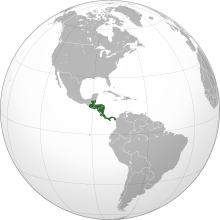Central American Isthmus
| Central America | |
|---|---|
 |
|
| Land area | 507,966 km2 (196,127 sq mi) |
| Population | 46,761,485 (2015-2016 estimate) |
| Density | 92/km2 (240/sq mi) |
| Countries | |
| Demonym | Central American |
| GDP | $203.73 billion (exchange rate) (2013) $370.52 billion (purchasing power parity) (2013). |
| GDP per capita | $4,783 (exchange rate) (2013) $8,698 (purchasing power parity) (2013). |
| Languages | Spanish, English, Mayan languages, Garifuna, Kriol, and other languages of Mesoamerica |
| Time Zones | UTC – 6:00, UTC – 5:00 |
| Largest cities (2010) | |
Central America (Spanish: América Central or Centroamérica) is the southernmost, isthmian portion of the North American continent, which connects with the South American continent on the southeast. Central America is bordered by Mexico to the north, Colombia to the southeast, the Caribbean Sea to the east, and the Pacific Ocean to the west. Central America consists of seven countries: Belize, Costa Rica, El Salvador, Guatemala, Honduras, Nicaragua, and Panama. The combined population of Central America is between 41,739,000 (2009 estimate) and 42,688,190 (2012 estimate).
Central America is a part of the Mesoamerican biodiversity hotspot, which extends from northern Guatemala through to central Panama. Due to the presence of several active geologic faults and the Central America Volcanic Arc, there is a great deal of seismic activity in the region. Volcanic eruptions and earthquakes occur frequently; these natural disasters have resulted in the loss of many lives and much property.
In the Pre-Columbian era, Central America was inhabited by the indigenous peoples of Mesoamerica to the north and west and the Isthmo-Colombian peoples to the south and east. Soon after Christopher Columbus's voyages to the Americas, the Spanish began to colonize the Americas. From 1609 until 1821, most of the territory within Central America—except for the lands that would become Belize and Panama—was governed by the Viceroyalty of New Spain from Mexico City as the Captaincy General of Guatemala. After New Spain achieved independence from Spain in 1821, some of its provinces were annexed to the First Mexican Empire, but soon seceded from Mexico to form the Federal Republic of Central America, which lasted from 1823 to 1838. The seven states finally became independent autonomous states: beginning with Nicaragua, Honduras, Costa Rica, and Guatemala (1838); followed by El Salvador (1841); then Panama (1903); and finally Belize (1981). Even today, though, people in Central America sometimes still refer to their nations as though they are provinces of a Central American state (e.g. it is still common to write "C.A." after the country names, in formal and informal contexts).
...
Wikipedia
